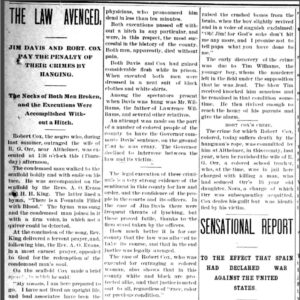calsfoundation@cals.org
Jim Davis (Trial and Execution of)
Beginning in the 1880s and increasingly as Jim Crow laws were instituted across the South, newspapers across the United States began to expand their coverage of Southern lynchings. In addition, publications like the Chicago Tribune and organizations like the National Association for the Advancement of Colored People (NAACP) and the Tuskegee Institute in Alabama began to keep annual lists of lynchings. In her 1895 book The Red Record, Ida B. Wells-Barnett also attempted to include a comprehensive list of lynchings. Further examination of some newspaper accounts, however, shows that subsequent articles, particularly local to the site of the lynchings, later corrected these stories to indicate that no lynching had indeed happened. Other events that were described as lynchings were actually executions performed after due process of the law. The latter is the case with an African-American man named Jim Davis.
In early December 1896, Jim Davis (also known as “Crazy Jim”) was accused of murdering one of the sons of his employer Joe Williams in Melton Township, Jefferson County. The Pine Bluff Semi-Weekly Graphic described the crime on December 8. Apparently, Davis was picking cotton with Williams’s two sons, Lawrence and his younger brother, on Saturday, December 5. The three got into an argument about the ownership of a puppy but apparently resolved it. Davis, however, continued to pick only to the end of his row and then went into the woods. Once there, he called the boys, saying he had something to tell them. He then attacked them with a large limb and a knife the younger boy was carrying. The younger son was injured, and Lawrence, the older son, was killed. Davis then returned to work in the field. The younger boy, although seriously injured, managed to crawl home and alert his father. When Davis saw Joe Williams approaching across the field, he ran. Two African-American farmers named L. M. Williamson and Billy Woods then hid Davis in the woods and fed him for two days. According to the December 16 issue of the Graphic, warrants were later issued for their arrest for allowing Davis to “escape from an outraged law and a just and deserved punishment.” In a confession published in the Graphic just before his execution, Davis stated that they had argued over a rabbit that his dog had caught.
According to reports in newspapers across the nation, Davis was eventually captured either near the scene of the crime or in the woods near Memphis, Tennessee. The Nebraska Advertiser reported on December 11 that a mob of farmers took Davis from the officers and fled south, and “it was almost certain that the mob had hanged their prisoner.” This account was repeated in numerous newspapers around the nation, including the Shiner Gazette, the Bryan Daily Eagle, and the Indianapolis Journal. Although a few newspapers corrected the record, the supposed lynching was included in the NAACP’s 1919 publication Thirty Years of Lynching in the United States and has also been included on subsequent lists.
The facts, however, are quite different. Davis was captured near Pine Bluff (Jefferson County), but he was jailed, indicted, and tried. On January 8, 1897, the jury returned a guilty verdict after deliberating for only twenty minutes. Although a group of local Black residents appealed to the governor saying that Davis was insane and should not be executed, the governor refused to intervene, and Davis was hanged in Pine Bluff on February 25, 1897.
For additional information:
“Accessories after the Fact.” Pine Bluff Semi-Weekly Graphic, December 16, 1896, p. 1.
“Additional Dispatches.” Nebraska Advertiser, December 11, 1896, p. 4.
“Crazy Jim Lynched.” Indianapolis Journal, December 9, 1896, p. 5.
“Guilty.” Pine Bluff Semi-Weekly Graphic, January 9, 1897, p. 1.
“Horrible, Horrible.” Pine Bluff Semi-Weekly Graphic, December 8, 1896, p. 1. (The physical copy of the newspaper shows December 8. The online search feature on Chronicle American, however, requires the user to click on December 9.)
“The Law Avenged.” Pine Bluff Semi-Weekly Graphic, February 27, 1897, p. 1.
“Murdered Two Boys.” Shiner Gazette (Texas), December 9, 1896, p. 2.
“Reported as Lynched.” Bryan Daily Eagle (Texas), December 10, 1896, p. 1.
Thirty Years of Lynching in the United States, 1889–1918. New York: National Association for the Advancement of Colored People, 1919.
Nancy Snell Griffith
Davidson, North Carolina
 Law
Law Post-Reconstruction through the Gilded Age, 1875 through 1900
Post-Reconstruction through the Gilded Age, 1875 through 1900 Jim Davis Article
Jim Davis Article 




Comments
No comments on this entry yet.